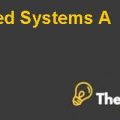Bio Information Analytics of Hypertrophic Cardiomyopathy Case Study Solution
Clinical Interpretation
In the proposed study, the method being used to identify the bio markers on the basis of the pathways in Hypertrophic cardiomyopathy (HCM) has been developed, through investigating and analyzing the dynamic interactions between numbers of molecules being related with the pathogenesis through an effective strategy i.e. co-expression network strategy. It has been analyzed that there are 447 differential pathways between normal samples and Hypertrophic cardiomyopathy (HCM) involving purine ribonucleoside monophosphate biosynthesis, folding of actin by CCT/TRiC, TRiC/CCT in actin and tubulin folding and cooperation of prefoldin.
Another altered pathway namely purine ribonucleoside monophosphate biosynthesis has been screened out in the proposed study. Since, the flow of energy has been generated from the ribose in purine ribonucleoside monophosphates (ibbs JB, 2016), the incapability for maintaining the utilization of ATP might be the HCM primary abnormality (Spindler M, 1998), and hence the purine ribonucleoside monophosphate biosynthesis differential pathways might be significant for the HCM progression, which would involve a response to the energy disruption.
Symptoms of Hypertrophic Cardiomyopathy
Patients who are diagnosed with hypertrophic cardiomyopathy sometimes may show no signs of symptoms because of no significant effect on the patients’ lives. However some of the common symptoms and complications that most of the patients faced are as follows:
- Difficulty in facing issues related to breathing.
- Inability to function properly or do exercise.
- Serious arrhythmias.
Implications for patients/family
HCM carries a number of implication for both patient and its families. It also affect the young healthy individuals of the family. Therefore it is highly considered to screen the lifestyle of the family members and to get genetic counseling.
HCM is heavily associated with sudden deaths of patients because of which the patients who are diagnosed with any such disease are asked to avoid any intense activity and workout. It is also recommended to maintain a balance of activities to keep the adequate level of hydration maintained and avoid any such activities that involve excessive vasodilation.
Moreover a family screening is important as this disease is often transmitted to off springs through genes. So in order to minimize the complication and identify SCD risk an appropriate steps must be under taken. The screening is done mostly during the adolescence phase when the emergence of LVH is most common.
Early evaluation and screening is commonly suggested when the history of the family has gone through various diseases or other severe concerns. In adulthood, the screening is suggested after every 5 years or in response to the clinical change, due to late development of LVH. (Martin S Maron, 2018)
Recommendations
The recommended therapy is ICD placement for the patients with HCM, with prior ventricular fibrillation, documented cardiac arrest, hemodynamically significant ventricular tachycardia. The recommended tests are listed below:
- Echo cardio gram
- Electrocardiogram
- Treadmill stress test
- Holter monitor
- Cardiac MRI
- Cardiac catheterization
The family screening includes:
- Genetic testing
- Echo cardio gram
In relation to the family screening of the dieses, the treatment includes;
- Medications
- Septal myectomy
- Septal ablation
- Implantable cardioverter-defibrillator (ICD)











